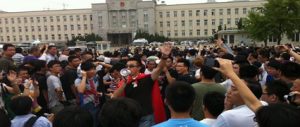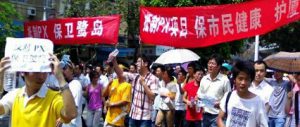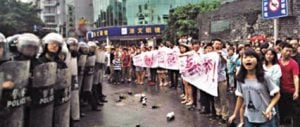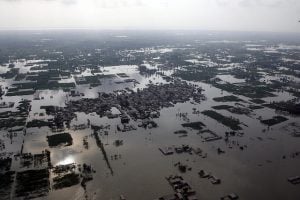Zhou Lin (a pseudonym), has chosen to research environmental protests as part of her Masters degree in environmental law at Peking University. But where to start? Where are the mechanisms to resolve environmental protests?
Zhou is not the only one scratching her head. On November 17, she attended an academic seminar called “Conflict Resolution in the Public Sector: Theory and Practice”. Participants included professors from universities, the Chinese Academy of Governance, and the Central Committee Party School, along with community representatives, NGO workers and even a judge.
The day-long seminar included four presentations on environmental protests. Host Chang Jian, a professor from the Zhou Enlai School of Government at Nankai University, repeatedly asked: “Apart from negotiations, what solutions are there?”
More incidents, more attention
Zhou Lin’s course materials are missing two striking statistics.
First, since 1996, the number of environmental protests in China has been growing by 29% per year. This figure came from Yang Zhaofei, vice-chair of the Chinese Society for Environmental Sciences, at a speech to a recent special meeting of the Standing Committee of the 11th National People’s Congress.
Second, over 300,000 petitions were received on environmental matters during the 11th Five Year Plan. China’s petitioner masses now include many with environmental complaints.
And, within just a few months of 2012, we saw popular protests sparked by environmental concerns in Shifang in Sichuan province, Qidong in Jiangsu and Ningbo in Zhejiang.
As early as 2009, Shan Guangnai, a researcher at the Chinese Academy of Social Sciences (CASS), predicted in Southern Weekend that environmental protests would become more common. “Illegal land seizures and relocations, labour disputes and environmental pollution are the three factors driving popular protests,” Shan said. That prediction has come true.
At a press conference during the recent 18th National Party Congress, environmental protection minister Zhou Shengxian said, when asked about the increase in environmental protests, that this was a “pattern” and that “the environment is currently a sensitive issue.”
At the same time, government bodies, from the National Development and Reform Commission (NDRC) – China’s top economic planner – to the Ministry of Environmental Protection (MEP), have been firing off various notices and announcements. This has been interpreted as a signal the issue is working its way up the government agenda. Meanwhile, experts in dealing with popular protest have become honoured guests at local government offices.
Motives for protest
Shan Guangnai is often quick on the scene when a protest breaks out. He says environmental protests are characterised by a strong sense of consensus, and rapid formation. As environmental issues are apolitical, participants feel less anxious about taking part than they otherwise might.
In 2005, repeated mass petitioning over environmental pollution in Dongyang, eastern China, led to clashes. Academics commonly recognise this as China’s first influential environmental protest.
Two years later, we saw the protests over the PX chemical plant in Xiamen, which became the classic case study of protest in China.
CASS professor Yu Jianrong contrasts the two cases, pointing out that, in Dongyang, protesters’ interests had already been harmed and they wanted “remedy after the fact”. In Xiamen, however, the public displayed a new, “preventative” form of protest, targeting a planned, rather than completed, project. “Potential risks” were now enough to arouse protest. {{fact_box}} In the past, moreover, protests commonly called for compensation, rather than making broader demands for environmental protection. Today, people are demanding better environmental and health rights, rather than financial or material compensation.
But has the question of whether or not the project itself is appropriate and legitimate become a secondary factor?
Yang Zhaofei, formerly the MEP’s chief nuclear safety engineer, points out that the smelting plant which triggered protests in Shifang was a post-earthquake reconstruction project with state support. The technology on the table for the scheme was by no means backward, and significant investment in environmental protection was planned. Expected spending on equipment to prevent pollution at the offending chemical plant in Ningbo, meanwhile, totalled 3.6 billion yuan (US$578 million). Many other sound, legal projects have been halted due to public objections, says Yang.
Another challenge for those responding to the protests is the range of different interests involved. Opposition is often caused by land requisition, relocations or losses to fisheries, but environmental protection provides a legitimate banner under which to protest.
MEP documents show that, in Shifang, regulations demanded that overall pollution should not increase with the arrival of the smelting project. This meant dozens of smaller chemical firms would have to close to make way for the new and larger plant. In Qidong, the planned pipeline to discharge waste into the sea was damaging property sales
It is notable that each of the three major protests of 2012 all involved an ill defined fear of technology. Protestors could not describe the dangers of paraxylene, the chemical that would have been manufactured in Ningbo, but still objected to the plant.
Improving public participation and rule of law
These protests start fiercely but end quickly. In Ningbo, Shifang and Qidong, local officials rushed to halt the projects and restore calm. Many observers believe a pattern has been established in which protests are necessary for resolution, and the size of the protest determines the amount of action taken.
Some 400 million yuan (US$64 million) of investment was lost to Shifang, and 6 billion yuan (US$963 million) in Ningbo. Shan Guangnai describes this as a “triple-lose” scenario: The local economy loses a sound and legitimate project; the project approval body loses public confidence; and the public loses what may have been a greener outcome. In Shifang, dozens of small chemical plants are polluting away as normal, and “the public isn’t complaining.”
A consensus on improving the situation has formed around a few key ideas:
Top of the list is ensuring the public’s right to know and participate. Although the environmental impact assessment system provides for openness of information and public participation, implementation at the local level is dubious. In Shifang and Qidong there was a period of at least two years between project proposal and approval, yet most locals were unaware of what was happening – much less participating.
On August 15, the MEP issued a new requirement that, from September 1, environmental impact assessments reports be accompanied by an abridged version to be made directly available to the public. That abridged version is to be “clear and to the point, easily understandable, use technical vocabulary in a standardised manner, and minimise descriptions of technical processes.”
Then there’s adopting a system for assessing risks to social stability. Zhong Gang (a pseudonym) works in a job which involves ensuring social stability in a coastal city. He noted that the government work report to the 18th National Party Congress included “establishing a robust system for assessing the risk to social stability arising from major policy decisions.”
“That’s the first time it’s been mentioned as a guiding principle, meaning that years of work have been recognised at the top level,” says Zhong.
In August – just a day after the environment ministry issued its notice on public access to environmental impact assessments – the NDRC issued a temporary method for “stability assessments” for major fixed-asset investments. Specifically, it stated that the stability assessment should form one section of the feasibility studies and application documents already required.
Sun Zhicheng of the Laws and Regulations Office at the NDRC’s Department of Investment, says: “This is the first NDRC requirement on stability assessments, and it’s a strict one.” Local governments and departments will now need to come up with the actual methods for carrying out stability assessments.
Meanwhile, there are widespread calls for the rule of law to be applied more widely in the environmental impact assessment process. Figures from the MEP’s petitioners’ department show that, during the 11th Five-Year Plan period (2006-2010) there were over 300,000 environmental complaints, prompting 2,614 administrative decisions to be re-examined. But there have been only 980 administrative court cases about environmental impact assessments, and only 30 criminal cases. Less than 1% of environmental disputes are resolved through legal channels.
Many of those interviewed for this article said that only by improving access to judicial redress and limiting government power would China get to the root of the problem. Yu Jianrong said that judicial channels bring conflicts out into the open, and arguments heard in court are more convincing than government-organised hearings.
Another important lesson from environmental protests is the need to turn to social groups for assistance, and to encourage the development of environmental NGOs. The environment ministry appears to have recognised this: in an on going revision of the environmental impact assessment regulations, it is working to include more content supportive of NGOs.
This article was first published in Southern Weekend.




